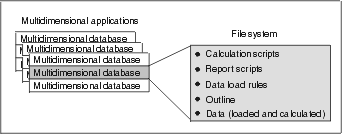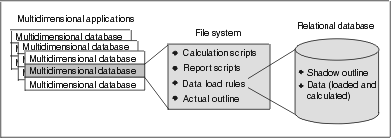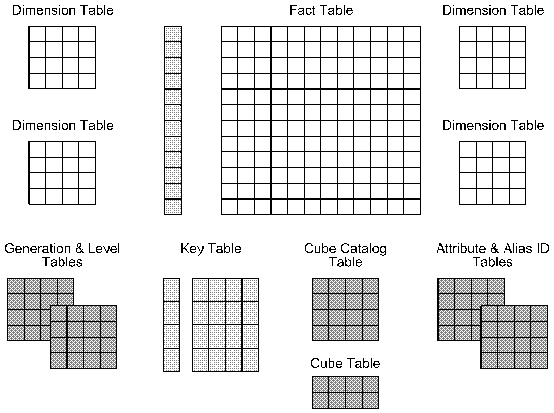
If you use the relational storage manager, when you use DB2 OLAP Server to create an OLAP application, DB2 OLAP Server creates the same components in the file system as when you use the multidimensional storage manager. It also creates a relational cube in your relational database that contains a shadow of the database outline and the actual data for the database.
If you use the multidimensional storage manager, when you create an OLAP application, all of its components are stored in the file system, as shown in Figure 4.
 |
If you use the relational storage manager, some of the components are stored in the file system, as shown in Figure 5, and some of the components are stored in your relational database.
 |
Figure 6 shows the relational cube DB2 OLAP Server creates in your relational database when you create an OLAP application and database using the relational storage manager.
Figure 6. DB2 OLAP Server relational cube
 |
For detailed information about the views that you can use to access the data in a relational cube directly, see Chapter 10, Creating SQL Applications.
The following sections provide an overview of the three events that cause DB2 OLAP Server's Relational Storage Manager to create tables or views in a relational cube. Those events are:
An OLAP application consists of one or more multidimensional databases and any calculation scripts, report scripts, and data load rules that you create for each of the databases.
Before you create an OLAP application, ensure that the parameters in your rsm.cfg file are updated appropriately. In the rsm.cfg file, you can set parameters that determine the relational database in which DB2 OLAP Server stores components of your OLAP applications and the table space in which it stores the relational tables it creates. For detailed information about updating those and related parameters in your rsm.cfg file, see Chapter 8, Configuring DB2 OLAP Server.
The first time you use DB2 OLAP Server to create an OLAP application, the following table and view are created:
When you use DB2 OLAP Server to create a multidimensional database in an
OLAP application, the tables and views shown in Table 11 are created.
Table 11. Tables and views created when you create a database
| Tables and Views | Description |
|---|---|
| Cube table | Contains a list of dimensions in a relational cube and information about each dimension. |
| Cube view | Allows an SQL user to access the names of all dimensions in a relational cube and associated information for each dimension. There is one cube view for each relational cube in your relational database. |
| Alias ID table | Contains a mapping of OLAP alias table names to ID numbers allocated by DB2 OLAP Server. |
| Alias ID view | Contains one row for each OLAP alias table used with a relational cube. There is one alias ID view for each relational cube. |
When you save the first outline for a multidimensional database, DB2 OLAP Server creates the tables and views listed in Table 12:
Table 12. Tables and views created when you save the first outline
| Tables and Views | Description |
|---|---|
| Key table | Equivalent to the Index for a multidimensional database, as described by the Hyperion Essbase documentation. The key table is a relational table that is created by DB2 OLAP Server after the first successful restructuring. |
| Fact table | Contains all data values for a relational cube. There are one or multiple fact tables for each relational cube. |
| Fact view | Used to directly access multidimensional data from SQL applications that manage the required joins to the dimension views. |
| Star view | Allows an SQL user to access data from the star schema in a single view with the JOIN already done. |
| LRO table | Contains a row for each linked object associated with data cells in the relational cube. |
| LRO view | Allows an SQL user to access the LRO information. |
In addition, DB2 OLAP Server creates the tables and views listed in Table 13 for each dimension in the outline.
Table 13. Tables and views created for each dimension
| Tables and Views | Description |
|---|---|
| Dimension table | Contains detailed information about the members in a dimension. There is one dimension table for each dimension in an outline. |
| Dimension view | Allows an SQL user to access information about members contained in a dimension. |
| User-defined attribute table | Contains a member ID and user-defined attribute name for each named member specified when you created the outline. There is one user-defined attribute table for each dimension in an outline. |
| User-defined attribute view | Allows an SQL user to access all user-defined attributes for a dimension. |
| Generation table | Contains generation numbers and names for each named generation specified when you created the outline. There is one generation table for each dimension in an outline. |
| Level table | Contains level numbers and names for each named level specified when you created the outline. There is one level table for each dimension in an outline. |
| Relational attribute table | Contains names, data types, and sizes of relational attribute columns added to this dimension. |
| Relational attribute view | Allows an SQL user to access the relational attribute columns for this dimension. |